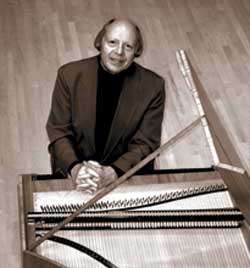

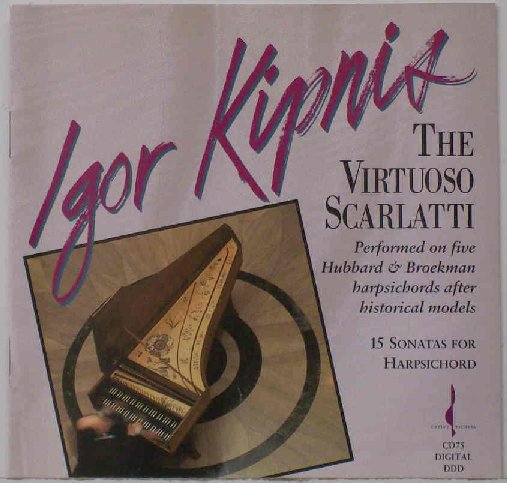 BD: Is it partly a tribute to you that there are
now so many performers on the harpsichord and the fortepiano?
BD: Is it partly a tribute to you that there are
now so many performers on the harpsichord and the fortepiano?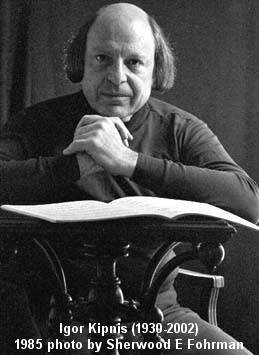 IK: So I took it leisurely. I would practice
from about eleven o’clock until three o’clock, with sufficient breaks.
At three o’clock they kicked me out because they would have a dance class,
and at that point I would have a sauna and a swim and just generally take
it easy. But I was afraid that if I didn’t practice I was going to
be in serious trouble, because once I reached England I had a recording session
with the Academy of Saint Martin in the Fields, consisting of five concertos
— three Bach harpsichord concertos, a Haydn concerto, and an earlier
Mozart Concerto, K.271. And about two days after that, I had my debut
at the Wigmore Hall. So that was really about the last time that I
was involved with a piano. I did make a recording for Kapp Records,
a very funny album called Toys + Orchestra
= Musical Fun. It had the Leopold Mozart Toy Symphony, and something by Karl Reinecke
called A Children’s Symphony which
had a piano obligato. So I dragged forth my “Schnabel”
tone as best I could. It was a lot of fun, but other than that, I didn’t
touch the piano at all over all of those years — decades — except
if I was doing a master class. I did many master classes where there
were nothing but pianists, which is what you would expect. There are
not that many harpsichord students even these days.
IK: So I took it leisurely. I would practice
from about eleven o’clock until three o’clock, with sufficient breaks.
At three o’clock they kicked me out because they would have a dance class,
and at that point I would have a sauna and a swim and just generally take
it easy. But I was afraid that if I didn’t practice I was going to
be in serious trouble, because once I reached England I had a recording session
with the Academy of Saint Martin in the Fields, consisting of five concertos
— three Bach harpsichord concertos, a Haydn concerto, and an earlier
Mozart Concerto, K.271. And about two days after that, I had my debut
at the Wigmore Hall. So that was really about the last time that I
was involved with a piano. I did make a recording for Kapp Records,
a very funny album called Toys + Orchestra
= Musical Fun. It had the Leopold Mozart Toy Symphony, and something by Karl Reinecke
called A Children’s Symphony which
had a piano obligato. So I dragged forth my “Schnabel”
tone as best I could. It was a lot of fun, but other than that, I didn’t
touch the piano at all over all of those years — decades — except
if I was doing a master class. I did many master classes where there
were nothing but pianists, which is what you would expect. There are
not that many harpsichord students even these days.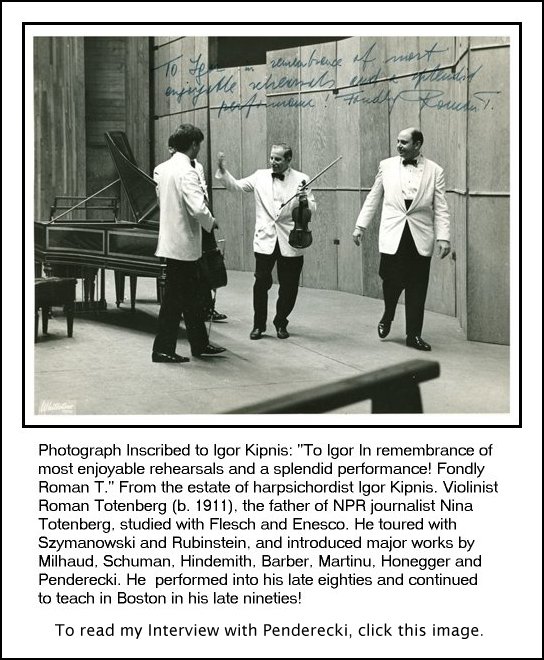 IK: There have been a lot. There’s a book
that is a catalog of harpsichord and clavichord music published by Fallen
Leaf Press, which is in Berkeley, California. It is six hundred pages,
plus. It’s astonishing and it shows every possible way the harpsichord
has been used — in combination, as a solo instrument,
in concertos — everything that you can possibly think
of. It lists a lot of pieces from the very early part of this century.
A lot of people think the harpsichord is of relatively recent interest, when
in fact the revival is well over a hundred years old. I have played
some of that early material. There’s a piece by Frederic Delius
— hardly the first piece since it dates from 1919 —
but it is absolutely impossible to play! When I play it
in concert and I can talk to the audience, which I often do, I tell them
I’m never sure that I’m going to get through this thing! I remember
one time early on in my career, I finished the concert and a woman came back
in the green room and sort of accosted me. She said, “Tell me, don’t
you miss the pedal?” meaning the sustaining pedal. Of course the harpsichord
doesn’t have a sustaining pedal. I think I was too dumbfounded at that
point to come up with a decent explanation other than, “Well, you know, Bach
didn’t have one of those things. It’s on the piano.” But no,
I don’t really miss it. However, when I would play the Delius, I’d
tell the people I do miss having the pedal. There you would need it.
But it’s a neat piece; it’s just bloody impossible!
IK: There have been a lot. There’s a book
that is a catalog of harpsichord and clavichord music published by Fallen
Leaf Press, which is in Berkeley, California. It is six hundred pages,
plus. It’s astonishing and it shows every possible way the harpsichord
has been used — in combination, as a solo instrument,
in concertos — everything that you can possibly think
of. It lists a lot of pieces from the very early part of this century.
A lot of people think the harpsichord is of relatively recent interest, when
in fact the revival is well over a hundred years old. I have played
some of that early material. There’s a piece by Frederic Delius
— hardly the first piece since it dates from 1919 —
but it is absolutely impossible to play! When I play it
in concert and I can talk to the audience, which I often do, I tell them
I’m never sure that I’m going to get through this thing! I remember
one time early on in my career, I finished the concert and a woman came back
in the green room and sort of accosted me. She said, “Tell me, don’t
you miss the pedal?” meaning the sustaining pedal. Of course the harpsichord
doesn’t have a sustaining pedal. I think I was too dumbfounded at that
point to come up with a decent explanation other than, “Well, you know, Bach
didn’t have one of those things. It’s on the piano.” But no,
I don’t really miss it. However, when I would play the Delius, I’d
tell the people I do miss having the pedal. There you would need it.
But it’s a neat piece; it’s just bloody impossible!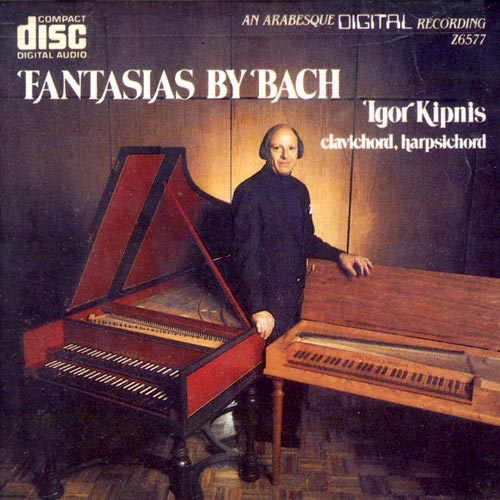 IK: First came the harpsichord. Then at one
point, one of my mentors, Thurston Dart, knew that I was getting a clavichord.
The clavichord is a very, very soft instrument, but it does have dynamics.
So all of a sudden I was able to put in dynamics — not because the harpsichord
was in any way lacking for expressive possibilities, only that here was something
else. When it came to repertoire, some things worked beautifully on
the harpsichord and sound terrible on the clavichord, and of course, vice
versa. And some of the clavichord repertoire appealed to me very much.
In 1980 I got my first fortepiano, and was very, very lucky in that it was
an actual antique — the only antique that I owned. It was a 1793 instrument
made by the Gravener brothers in Dresden.
IK: First came the harpsichord. Then at one
point, one of my mentors, Thurston Dart, knew that I was getting a clavichord.
The clavichord is a very, very soft instrument, but it does have dynamics.
So all of a sudden I was able to put in dynamics — not because the harpsichord
was in any way lacking for expressive possibilities, only that here was something
else. When it came to repertoire, some things worked beautifully on
the harpsichord and sound terrible on the clavichord, and of course, vice
versa. And some of the clavichord repertoire appealed to me very much.
In 1980 I got my first fortepiano, and was very, very lucky in that it was
an actual antique — the only antique that I owned. It was a 1793 instrument
made by the Gravener brothers in Dresden.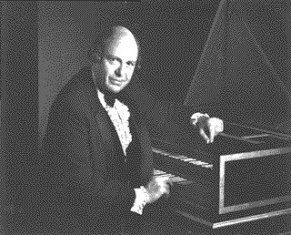 IK: That is not a difficult question for me to answer.
Music is my religion. Really, it is as simple as that. I want
to communicate the music, and my attitude in programming is communication.
In the very best sense of the words, I want it to be entertaining and varied.
I want to be able to lift something up. You can get philosophic; you
can talk about the spiritual, but the main thing is that people should enjoy
it. I decry the lack of classic music, although I mentioned not very
long ago the solo harpsichord situation. Nobody wants to go hear one.
They think this is a boring thing. It doesn’t have to be boring.
I like personality in performance very much. That doesn’t mean that
you have to exaggerate.
IK: That is not a difficult question for me to answer.
Music is my religion. Really, it is as simple as that. I want
to communicate the music, and my attitude in programming is communication.
In the very best sense of the words, I want it to be entertaining and varied.
I want to be able to lift something up. You can get philosophic; you
can talk about the spiritual, but the main thing is that people should enjoy
it. I decry the lack of classic music, although I mentioned not very
long ago the solo harpsichord situation. Nobody wants to go hear one.
They think this is a boring thing. It doesn’t have to be boring.
I like personality in performance very much. That doesn’t mean that
you have to exaggerate. 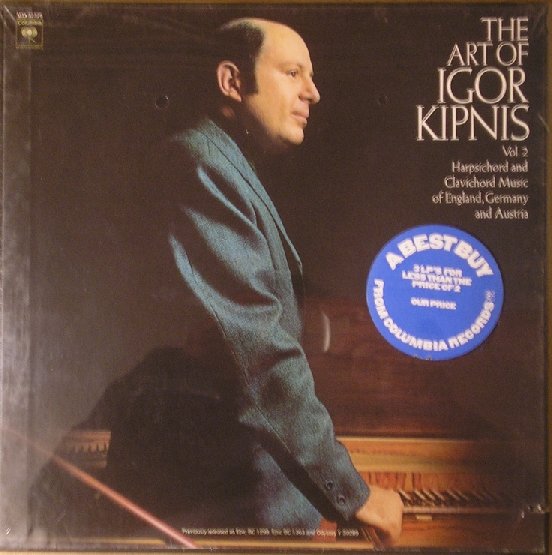 BD: Do you enjoy making recordings? You’ve
made a number of them.
BD: Do you enjoy making recordings? You’ve
made a number of them.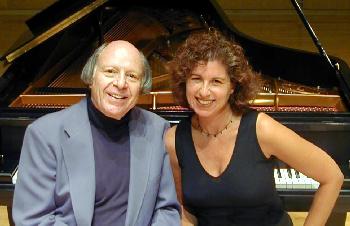 IK: Yeah! When Karen and I started touring,
[photograph at right] we began doing
outreach programs. That’s sort of a magic word. Lots of people
are into this — providing there’s some money to pay
for it, because you can’t really always do it for nothing. It’s not
an expensive deal, and we’ve been doing this for five years or more.
In general, we’ve concentrated on fourth, fifth, and sixth grades.
IK: Yeah! When Karen and I started touring,
[photograph at right] we began doing
outreach programs. That’s sort of a magic word. Lots of people
are into this — providing there’s some money to pay
for it, because you can’t really always do it for nothing. It’s not
an expensive deal, and we’ve been doing this for five years or more.
In general, we’ve concentrated on fourth, fifth, and sixth grades.|
Igor Kipnis, Dead at 71
By Wes Phillips [From Stereophile Magazine] February 3, 2002 — Igor Kipnis, virtuosic harpsichordist, prolific critic, and esteemed teacher died January 23. He was 71. According to his managing agency, Marilyn Gilbert Artists Management of Toronto, he had been suffering from cancer. Kipnis, the son of Metropolitan Opera bass Alexander Kipnis, was born on September 27, 1930 in Berlin, where his father was singing with the Berlin State Opera. Although Jewish, the elder Kipnis was popular in Germany during Nazism's rise to prominence. Employing the stratagem of a vocal injury, the elder Kipnis fled Germany for Austria. When the Nazis annexed that country, the family was touring Australia. They moved to the US just prior to the country's entrance into WWII. As a young man, Igor Kipnis was an enthusiastic record collector. "The family phonograph loomed large in my early years," he said. His passion for the harpsichord came about, in fact, as a result of his record collecting. Having purchased Edwin Fischer's epochal recording of Bach's Well-Tempered Clavier, he was irritated to discover it contained, as "filler," Wanda Landowska's harpsichord performance of the composer's second English suite. "As it turned out," Mr. Kipnis later reported, "this apparent rip-off soon fascinated me more than any of the many Bach piano discs I had, and I longed to try a harpsichord in the flesh sometime." He fulfilled that fantasy at college—Harvard, where he majored in social relations. In 1957, while he was employed at Westminster Records, where he was in charge of covers and liner notes, his parents presented him with a small harpsichord they had obtained in Europe. Kipnis essentially taught himself to play the harpsichord and developed many of his signature techniques on his own. He "traded" lessons with Fernando Valenti, another early champion of the instrument, exchanging lessons for meals cooked by Kipnis' wife, Judith Robison. According to Mr. Kipnis, his father was his major musical influence. He learned a huge repertory accompanying his father's students on the piano. Even more important than this exposure to the literature, he claimed, was the way it taught him the importance of a singing line. His father also "advised me to talk to audiences in my concerts, just as he had done so often in his American tours." Mr. Kipnis made his debut in 1959 and made a living as the "go to" continuo harpsichordist for a variety of New York–based Baroque and Renaissance performance ensembles. It was at this time that he began writing criticism professionally—another vocation he continued to practice over the years, as a music critic and contributing editor for The New York Herald Tribune, Stereo Review, Stereophile, and Fi. Mr. Kipnis' records were well-received by the public and critics alike. He recorded over 80 albums for CBS, Angel, Fontana, and Arabesque. His approach was stylish and intimate, almost conversational, and he knew how to get the most out of his instrument's limited dynamic range. "The harpsichord surprises people," he said. "They expect it to be wearing a wig and belonging in somebody's attic. I try to bring it out of the attic." He once referred to himself as "your basic cocktail harpsichordist," because he would perform in unstuffy venues, such as college cafeterias, using amplification while maintaining a running commentary. He claimed one of his harpsichords—a French-style instrument he liked to pack into his van and tour with—had more miles on it than most cars. In later years, he also performed on clavichord and fortepiano—and even the contemporary piano. In 1995 he formed a duo with Karen Kushner, playing four-handed music in concerts and recitals. In 1971 he took a fulltime faculty position at Fairfield University in Connecticut, cutting back on his touring schedule. He was president and artistic director of the Friends of Music of Fairfield County for five years, artistic director of the Connecticut Early Music Festival for 13 years, as well as head of Tanglewood's Baroque department. He also taught at Harvard, the Peabody Institute, and the Mannes School of Music, among other educational institutions. Mr. Kipnis is survived by a son, Jeremy, a highly regarded recording engineer, and a world that, in no small part because of his life's work, no longer finds the harpsichord a curiosity, but rather a valued voice in the authentic and serious recreation of Baroque and Renaissance music. |
|
[This biography of Alexander Kipnis
was prepared for my article Massenet, Mary Garden, and the Chicago Opera
1910-1932.]
Alexander Kipnis (February 13 [O.S. February 1] 1891 – May 14, 1978) was a Russian-born operatic bass. Having initially established his artistic reputation in Europe, Kipnis became an American citizen in 1931, following his marriage to an American. He appeared often at the Chicago Opera before making his début at the Metropolitan Opera in New York City in 1940. Aleksandr Kipnis was born in Zhytomyr, the capital of the Volhynian Governorate, in the Russian Empire (now Ukraine). His impoverished family of seven lived in a Jewish ghetto. After his father died, when he was aged 12, he helped support the family as a carpenter's apprentice and by singing soprano in local synagogues and in Bessarabia (now Moldova) until his voice changed. As a teenager he took part in a Yiddish theatrical group, until he entered the Warsaw Conservatory at age 19. The conservatory did not require a high-school diploma. His education included the study of the trombone, double bass and conducting. All the while he continued to sing in synagogues. On the recommendation of the choirmaster, he traveled to Berlin and studied voice with Ernst Grenzebach who was also a teacher of Lauritz Melchior, Meta Seinemeyer, and Max Lorenz. At the same time he sang second bass in Monti's Operetta Theater. 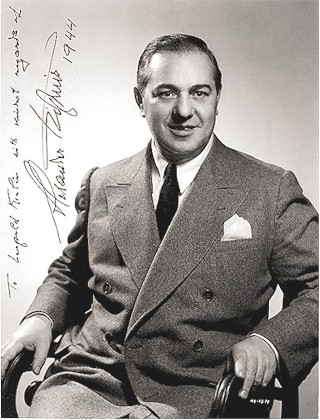 When the First World War started, Kipnis was interned as an alien in a German
holding camp. While singing to himself he was overheard by an army captain
whose brother was general manager of the Wiesbaden Opera. Kipnis was released
from custody and he was engaged by the Hamburg Opera. He made his operatic
debut in 1915, singing three Johann Strauss songs as a "guest" in the party
scene of the operetta Die Fledermaus. In 1917, he moved to the Wiesbaden
Opera, having gained invaluable stage experience. He sang in more than 300
performances at Wiesbaden until 1922, when he joined the Berlin Staatsoper.
When the First World War started, Kipnis was interned as an alien in a German
holding camp. While singing to himself he was overheard by an army captain
whose brother was general manager of the Wiesbaden Opera. Kipnis was released
from custody and he was engaged by the Hamburg Opera. He made his operatic
debut in 1915, singing three Johann Strauss songs as a "guest" in the party
scene of the operetta Die Fledermaus. In 1917, he moved to the Wiesbaden
Opera, having gained invaluable stage experience. He sang in more than 300
performances at Wiesbaden until 1922, when he joined the Berlin Staatsoper.The following year Kipnis visited the United States with a touring Wagnerian company. For nine seasons, between 1923 and 1932, he was on the roster of the Chicago Civic Opera. In 1927, at the Bayreuth Festival, he appeared as Gurnemanz in Wagner's Parsifal under Karl Muck and recorded the Good Friday Music under Siegfried Wagner. (A purported live performance recording in 1933 under Richard Strauss has been generally discounted.) He also appeared at the Salzburg Festival. Kipnis was under contract with the Berlin Opera until 1935, when he was able to break his contract and flee Nazi Germany. He appeared for three seasons as a guest performer with the Vienna State Opera in 1936-1938. Just after the Anschluss he left Europe and settled permanently in the United States. By the time he was finally signed by the Metropolitan in 1940 he had appeared in most of the world's major opera houses. In addition to those European and American theatres already mentione, he was heard at the Royal Opera House, Covent Garden, (in 1927 and 1929–1935), and also at the Teatro Colón in Buenos Aires (1926–1936). Kipnis was regarded throughout the inter-war years as being one of the greatest basses in the world. He was praised for the beauty of his smooth and mellow voice and the excellence of his musicianship. As befitted his status, he was invited to appear with the top conductors of his day. He retired from the Met in 1946. He made his last concert appearance in 1951. Since his debut in 1915, he had sung at least 108 roles, often in more than one language, and his performances in opera and oratorio numbered more than 1600. He died in Westport, Connecticut in 1978, aged 87. Kipnis' son Igor Kipnis (1930–2002) was a celebrated harpsichordist. Following in similar creative footsteps, Kipnis's grandson, Jeremy R. Kipnis (born 1965), has become known as a photographer, record producer, film director, and recently creator of The Kipnis Studio Standard - The 21st Century Ultimate Screening Room Design, an evolution of George Lucas's and Tom Holman's THX Motion Picture & Sound Standards. “My father was born into a pitifully poor family in the Ukraine and had little going for him as a young boy except for a rather sweet soprano voice. One day, a visiting cantor from Bessarabia heard the lad singing in the local synagogue choir and persuaded my father’s mother, with the promise of some payment, to let him take the child back to his own synagogue to sing. During this period of a few years, my father was befriended by one of the choir’s male singers. The town of Novybug, with its largely unpaved streets, had particularly muddy paths when the post-winter thaws came and whenever it rained. In exchange for singing lessons and the rudiments of reading music, my father would scrupulously scrub the rubber boots of the older singer. One of the pieces the older man introduced him to was “Der Leiermann,” the haunting final song from Schubert’s Winterreise. My father was affected by the sad, almost frozen tune of the organ grinder, and in later life he often related how, as a young boy, he loved songs in minor keys and could not understand why anyone should ever want to write in the major mode.” (Igor Kipnis) 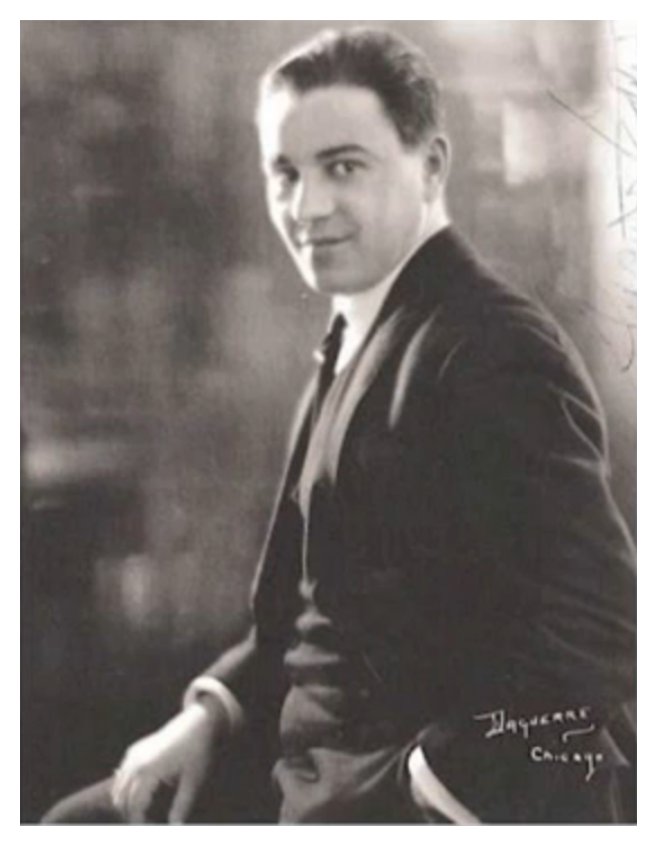
|
This interview was recorded in Evanston, IL, on April 5, 2001.
Portions (along with recordings) were used on WNUR one year later.
This transcription was made and posted on this website in 2010.
To see a full list (with links) of interviews which have been transcribed and posted on this website, click here. To read my thoughts on editing these interviews for print, as well as a few other interesting observations, click here.
Award - winning broadcaster Bruce Duffie was with WNIB, Classical 97 in Chicago from 1975 until its final moment as a classical station in February of 2001. His interviews have also appeared in various magazines and journals since 1980, and he now continues his broadcast series on WNUR-FM, as well as on Contemporary Classical Internet Radio.
You are invited to visit his website for more information about his work, including selected transcripts of other interviews, plus a full list of his guests. He would also like to call your attention to the photos and information about his grandfather, who was a pioneer in the automotive field more than a century ago. You may also send him E-Mail with comments, questions and suggestions.